When Germany shut down nearly half of its nuclear capacity in the week after Fukushima, critics charged that the country would only be importing more nuclear power from its neighbors as a result. Craig Morris says it is a physical impossibility.
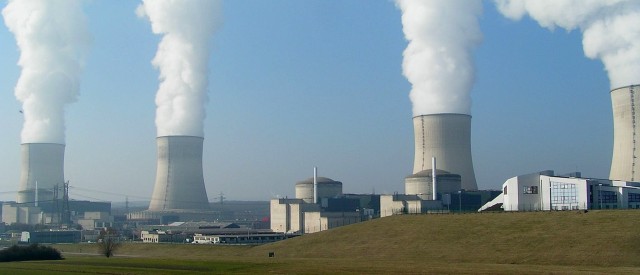
Inflexible, outdated, potentially dangerous – and certainly not more important for Germany’s energy mix since Fukushima – French nuclear power. (Photo by Stefan Kühn, CC BY-SA 3.0)
Perhaps the best example of such claims is an article published in September 2011 by Der Spiegel. The opening paragraph sums up the argument well: “the country is now merely buying atomic energy from neighbors like the Czech Republic in France.” Later, we read that “the Czech nuclear industry went into the export business. These days, it’s sending roughly 1.2 gigawatts-hours of electricity across the border every day.”
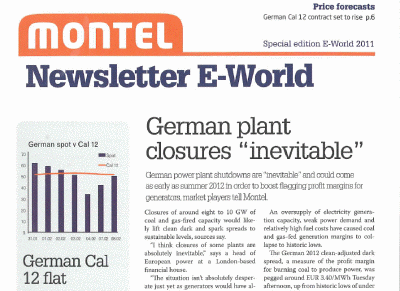
The month before Fukushima, Montel – a publisher in the energy sector – spoke of “an oversupply of electricity generation capacity” in Germany in a newsletter. Nonetheless, the popular press told the public that the nuclear phaseout of 2011 would make Germany dependent upon its neighbors. In the three years since, German power exports have soared. Source: Montel.
Embarrassingly, it gets worse from there: “The country has gone from being an energy exporter to an energy importer practically overnight” – this sentence is wrong in two ways. First, electricity (what we are talking about here) is only one form of energy, which is generally broken up into heat, motor fuel, and electricity. In terms of energy, Germany has been a major net importer for a long time and will remain so for the foreseeable future.
But – second – since the nuclear phaseout of March 2011, power exports in Germany have boomed. Germany remained a net power exporter in 2011 (PDF). 2012 was a record year. So was 2013. 2014 in shaping up to be a fierce competitor for the title (PDF).
Spiegel also gets the situation wrong for Austria by claiming that the country “first imports inexpensive nuclear power from the Czech Republic,” stores it as pumped hydropower, and sells it to its neighbors “at a much higher price.” The article adds that Austria aims to expand this strategy in order to become an exporter to Germany by 2015. Apparently, Spiegel did not see another policy coming in Austria – the country completely banned imports of all nuclear power in the summer of 2013 starting in 2015.
Last year, I discussed the physical impossibility of Germany importing more nuclear power (follow that link for a discussion of France, and click here for Poland). Nuclear plants generally run at full capacity, meaning they cannot be ramped up any further – at least not significantly. Based on an extensive study published by Öko-Institut, I talk about how the nuclear phaseout of March 2011 does not even show up on power trading graphs or nuclear production in Germany’s neighboring countries, but here’s one I did not share with you back then – power trading with the Czech Republic.
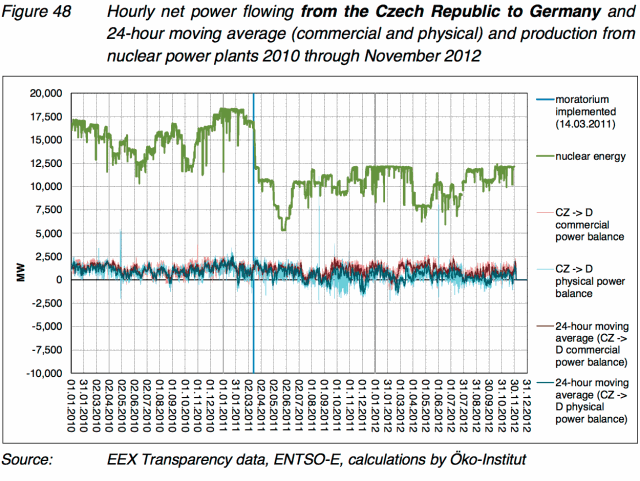
This chart requires some explaining, so bear with me. The top green line represents nuclear power production within Germany. The blue vertical line shows when Germany shut off roughly 40 percent of its nuclear capacity after Fukushima. As we see, nuclear power production immediately fell, but – as chance would have it – a few power plants were also simultaneously scheduled for refueling two months later, so nuclear production was cut in half again – an event that did not cause any problems and went almost completely unreported. Within just 10 weeks, nuclear power production in Germany fell temporarily from around 18 GW to just over 5 GW, and nothing went wrong.
Moreover, power trading remained unaffected. Look at the two curves at the bottom. The red line shows commercial trading (think of it as actual purchases); the blue one, physical trading (think of it as shipping – chocolate I purchase from Brussels may pass through France to reach me in southwest Germany, but it would show up under physical, not commercial trading, for the French). Before March 2011, it looks like Germany was already purchasing Spiegel’s “1.2 gigawatts-hours” from the Czechs. There does not seem to be a lot of change in the ten weeks after 11 March 2011, when German nuclear power production is cut by two thirds. Something weird seems to be going on around October 2011, but nothing special is happening with German nuclear power production then.
Here’s the situation between Germany and France at the time just to complete the picture:
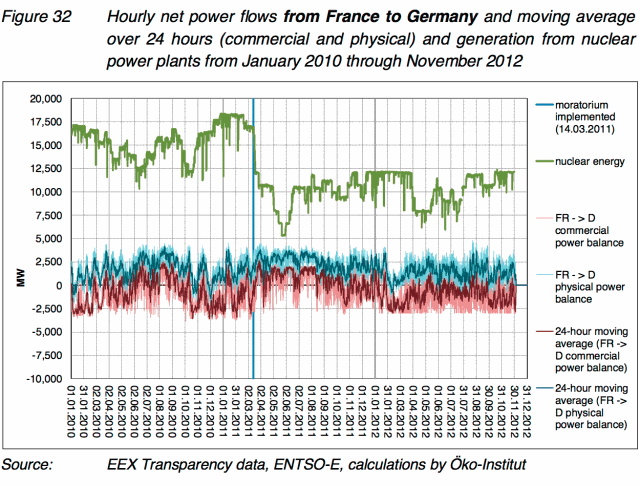
Clearly, the overall power trading situation (both commercial and physical) between Germany and France and between Germany and the Czech Republic does not seem to change much relative to German nuclear power production. Indeed, it cannot, as the following chart shows:
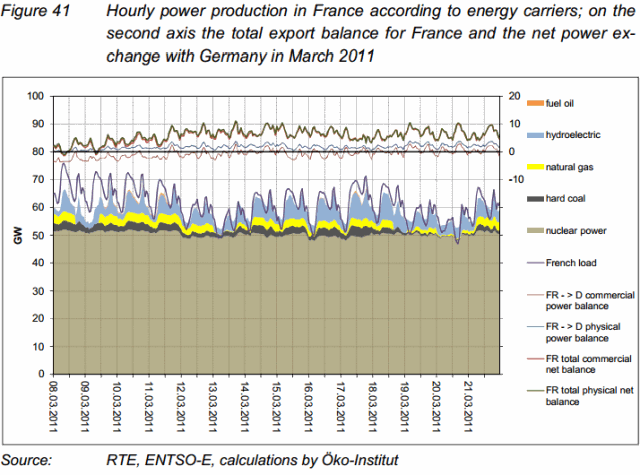
Here, we see nuclear power production (the big beige area) in France in March 2011. German nuclear power production is not shown here, and it is hard to see any effect at all. Like those in the Czech Republic, France’s nuclear plants run full blast whenever they can. If the Germans need additional electricity, they cannot get it from French and Czech nuclear plants.
The result of this situation has been massive overcapacity in Germany, which not only has to serve its own peak demand, but also help out its neighbors when demand is highest. Surrounded by inflexible baseload power plants, Germany exports when demand is high and imports when demand is low. Not surprisingly, the value of an exported kilowatt-hour from Germany was greater than the value of one imported in 2012 (the data for 2013 have not yet been published).

No German nuclear plant is within 30 kilometers of a neighboring country, and only three of them are within 80 kilometers. But France and Switzerland have installed four nuclear plants within 30 kilometers of the German border, and six are within 80 kilometers if we include the Czech Republic.
So no, Germany has not imported more nuclear power from abroad during its nuclear phaseout. We do, however, continue to run the risks. From my home in Freiburg, Germany, it is 25 kilometers as the bird flies to France’s oldest nuclear plant – and around 60 kilometers to the world’s oldest in Switzerland. Needless to say, if you buy a house here, no insurance firm will cover you against a nuclear accident. Nuclear remains un-insurable.
Craig Morris (@PPchef) is the lead author of German Energy Transition. He directs Petite Planète and writes every workday for Renewables International.
You’ve got the graph for France’s electricity production in March 2011 twice, and the graph that was supposed to go before that one seems to be missing.
Also, wow, I didn’t know the situation with the French nuclear plants and their distance to the German border is this bad.
Dear Vivi, thanks for pointing out the graph on power trading with France was missing – I had incorrectly uploaded the graph on power production in France twice. The error should be corrected now. Alexander
Very interresting! This information will come in handy, when the argument comes up the next time!
What was the makeup of German electricity generation since 2011? If nuclear went down and consumption remained unchanged, either imports increased or other generation increased. Imports don’t seem to have increased by 13GW from Czech or France if I read correctly.
If Germany is importing power from France, the “source” of the electricity it is importing is exactly proportional to the sort of power being generated. Anything else is at best confusion or at worst intentional obfuscation.
If I am a farmer, and I produce 70% GMO and 30% non GMO corn, and then blend all of that corn together and make corn tortillas out of it, those corn tortillas could not be considered GMO free under any labeling law anywhere. I understand that you want to believe Germany is not importing foreign nuclear power, but it is the simple truth.
What is a true environmental travesty is that Germany’s coal usage increased 5% in 2012… that is simply inexcusable and a complete failure.
As to whether nuclear power is insurable, many private insurers would disagree with you. Nuclear plants in the US carry billions of dollars in private insurance, they are by law required to carry this insurance, but insurance companies are not required to provide it! Instead, insurance companies provide it out of their own free will as it is a highly profitable type of insurance to offer. When it comes to private homes, anyone in the US can purchase insurance against nuclear fallout. It is just like hurricane and earthquake insurance, which are not required by law to be part of standard homeowners insurance.
The market for this extra coverage is also extremely small, so you will need to call and contact a larger insurance company to purchase it. I did out of curiosity previously check if it was available as I’ve heard this claim before, and I can assure you it is quite possible to purchase insurance through at least Berkshire insurance and likely others. The European insurance market may be less efficient, so I can’t speak for that.
I’m a little confused – you say that “In terms of energy, Germany has been a major net importer for a long time and will remain so for the foreseeable future,” but then immediately follow that up with, “power exports in Germany have boomed. Germany remained a net power exporter in 2011.” You explained that electricity is a component of energy, but how does energy differ from power, and how can Germany be a net importer of one but an exporter of the other?
Caitlin, the text explains that “electricity (what we are talking about here) is only one form of energy, which is generally broken up into heat, motor fuel, and electricity.” So Germany is a net exporter of electricity, which makes up a fifth of its energy demand, but it is nearly completely reliant upon imports for oil as a motor fuel (2/5 of energy demand) and natural gas, the biggest source of heat (the other 2/5 of energy demand).
However this is not really the problem is it? Since 2010 Germany has decreased its electricity generation via nuclear and gas generation and increased its coal and renewables electricity generation by about the same amount (circa 20 TWh). However despite a reduction in electricity demand of 17 TWh, CO2 emissions have increased over that period and consequently, exports have had to increase. So Germany is generating too much power as the variability of the grid has increased. This is the main problem.
Don, “Germany is generating too much power as the variability of the grid has increased. This is the main problem.” I had not heard that explanation before.
The export situation is primarily the result of lower prices. In turn, they result from a lower capacity factor conventional power plants. Renewables are simply being built faster than conventional plants are being taken down – including the nuclear phaseout. It’s not variability, but the general squeeze on the residual load covered by conventional plants.
The question only makes sense if you live in a parallel universe where nuclear power is worse than coal power. However, in the real world the opposite is the case, by a long margin, and more and more real environmentalists (e.g. George Monbiot, James Hansen, Barry Brook) realise how they were hoodwinked by the lies of the anti-nuclear movement into indirectly supporting the truly lethal coal industry.
The facts could not be clearer. According to the WHO/UNSCEAR report on Chernobyl, a total of 4000 excess cancer death from radiation can be expected if the linear non threshold model is applied. This is pretty bad, but fades in comparison with 3.7 million premature deaths every year due to outdoor air pollution, to which coal burning is a major contributor.
Then there is the issue of CO2 emissions leading to the very dangerous long term effects of global warming and ocean acidification. By closing its nuclear plants early, instead of coal plants, Germany, at the stroke of a pen, has unnecessarily commited an additional 1.5 billion tons of CO2 to the atmosphere. This is an unacceptable price for Frau Merkel’s failed attempt to turn the Baden-Wuerttemberg elections around.
So I challenge anyone to give me reasons why coal, especially brown coal, is preferable to nuclear power from safe and modern plants like the ones that are being closed in Germany.
Dear Sir/Madam, I just read somebody’s saying on FB, which claimed: Germany shut down lots of nuclear power plant, but keep buying lots of nuclear power from other country like France to compensate the nuclear power plant they’d shut down. Even worse, he claimed the power plant which next to Germany border has all power grid toward Germany not France.
To me, it is ridiculous to claim that France nuclear power plant would transmitted all electricity (or majority portion) to other country, but I can’t find any statistics to prove Cattenom and Fessenheim Nuclear Power Plant generate power to France mostly. Is there any way for me to obtain these kind of data? Thanks!
That graph showing the evacuation zones is very misleading. Read this..
http://www.world-nuclear.org/info/Safety-and-Security/Safety-of-Plants/Appendices/Fukushima–Radiation-Exposure/
The after-effects of the fallout from fukushima are paltry next to much more frequent conventional industrial accidents. Indeed, in most of the evacuation zone ambient dose rates are lower than what you’d get living in a granite area (Cornwall in the UK, for example).
It’s generally accepted that the most harmful effect of Chernobyl was the process of evacuation itself, which resulted in sky-rocketing suicide rates, drug addiction, depression, unprotected sex et al. The rate of cancer development in the affected population seems like a large number (although it is impossible to forecast) but is certainly indistinguishable from background rates of spontaneous cancer development. It is certainly true that the number of people known to have died from radiation effects (stochastic or deterministic) from Chernobyl is generally exceeded on a monthly basis by the number of people killed on UK roads. Actually, people killed in firearms incidents in America trumps it over a typical spring break.
We have to be very careful when presenting risk and means to mitigate it – overstating things can be extremely harmful to people affected by them. Frankly, an 80km evacuation zone around Fukushima is a farce, given the devastation caused by the natural disaster (which never gets talked about by the way – the one that people hid from in the only remaining structures – the reactor buildings). For more information on why the presentation of risk is such a difficult subject, I point you to the UK government’s excellent paper “Reducing Risks, Protecting People” (irritatingly abbreviated to R2P2). The debate around nuclear energy needs to be impartial, informed and calm. Sadly too much of the noise from one side is ideological and linked to the likes of CND and Greenpeace (in the UK at least). I have not yet met a credible nuclear expert with dreadlocks and tie-dye t-shirts.